India
Thiruvannamalai
My final destination, Ramana Ashram!
My trusted taxi driver and I set out from Pondicherry to the town of Thirumvannamalai, which is one of the great temple towns of South India as well as the site of various Ashrams, such as Ramanasramam (they stick an extra 'am' at the end of 'ashram' in the native tongue of Tamil).
The drive was beautiful, through many villages, sugar cane and rice fields. The rice field were especially beautiful, with the brightest green foliage I've ever seen in the rice shoots. The scenery was one of rural beauty, only diminished a bit by the cloudy weather and threat of rain. The drive was easy, in fact most of the traffic was coming the other way - there is huge, huge festival in Thiru that culminates on the full moon in the Kattika (Nov-Dec) month, which this year was Dec 3rd in India. In fact, I booked my reservation at Ramanasramam many months ago by email, and the manager said that the earliest I could get in was Dec 5, when the town emptied. The festival celebrates the sacredness of Arunachala mountain as a physical manifestation of Lord Shiva. Apparently hundreds of thousands of people cram into town for the festival, which must be a true madhouse, even for India!
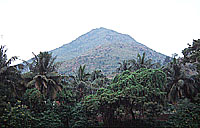 One point of interest on the way was the town
of Gingee (pronounced 'Shinshee'), a temple town
amidst huge boulder structures similar to Joshua
Tree National Park in California. Passing
through Gingee, the flat landscape changed into
one of distant mountain chains, isolated mountains
and hills, all very unique and of a distinctive
character. At this point, I could start to feel
the 'field' of Arunachala, a force that was distinct
and real, which made me very happy. I never thought
I would get to see the place, the mountain, where
Ramana Maharshi, 'the sage of Arunachala', practiced
in cave, blessed devotees and benefitted all
mankind spiritually.
One point of interest on the way was the town
of Gingee (pronounced 'Shinshee'), a temple town
amidst huge boulder structures similar to Joshua
Tree National Park in California. Passing
through Gingee, the flat landscape changed into
one of distant mountain chains, isolated mountains
and hills, all very unique and of a distinctive
character. At this point, I could start to feel
the 'field' of Arunachala, a force that was distinct
and real, which made me very happy. I never thought
I would get to see the place, the mountain, where
Ramana Maharshi, 'the sage of Arunachala', practiced
in cave, blessed devotees and benefitted all
mankind spiritually.
Upon coming into the outskirts of Thiruvannamalai, it became clear which mountain was Arunachala, out of the various mountains dotting the landscape. For me, it was a kind of "Close Encounters of the Third Kind" kind of feeling, seeing the mountain, like it was a home or place of enormous significance, not only for me, but for many. Arunachala towers over the town like some big, big brother, and the town comes right up to the base of the mountain. Thiru is just another town, in terms of structure, but it is a spiritual vortex (or near one), and it contains numerous ashrams, sadhus and temples.
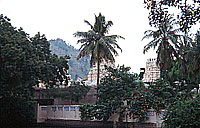 We pulled into Ramanashram in the mid afternoon and
the manager, Dr. Shiva, gave me the key to my dorm
room, which lies in an area away from the main buildings.
In order to get there, I passed by the samadhi site
of Ramana Maharshi and another of his mother. Ramana's
site is in a huge marble hall that is served by a
number of priests and pujarists.
We pulled into Ramanashram in the mid afternoon and
the manager, Dr. Shiva, gave me the key to my dorm
room, which lies in an area away from the main buildings.
In order to get there, I passed by the samadhi site
of Ramana Maharshi and another of his mother. Ramana's
site is in a huge marble hall that is served by a
number of priests and pujarists.
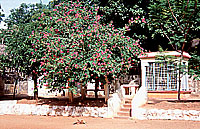 Past the samadhi site hall is a large building containing
the dining hall. Walking towards my room, past the
dining hall, into a large courtyard, I noticed small
shrines to several animals that Ramana was fond of,
such as Valli, a deer, a crow, and Lakshmi, a cow.
On my way to my room, a family of monkeys were playing
in the trees and on the ground, looking for food and
playing around. And to my surprise, there were two
beautiful peacocks just near my room - they make this
wonderful, haunting call when they cry out.
Past the samadhi site hall is a large building containing
the dining hall. Walking towards my room, past the
dining hall, into a large courtyard, I noticed small
shrines to several animals that Ramana was fond of,
such as Valli, a deer, a crow, and Lakshmi, a cow.
On my way to my room, a family of monkeys were playing
in the trees and on the ground, looking for food and
playing around. And to my surprise, there were two
beautiful peacocks just near my room - they make this
wonderful, haunting call when they cry out.
My room was simple, an iron bed with a small mattress, and a nightstand. The toilet was Indian style, of course, which by now, I found to be superior to western toilets - but it's more difficult to read magazines while squatting! No shower or bath, just a bucket for bathing (the women however, could order buckets of hot water). The room came with broom and the mandatory ceiling fan for South India.
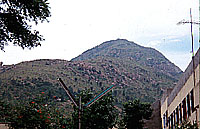 To my surprise and annoyance, who do I see on the
ashram grounds but Kumar Iyer, the young fellow whom
I met in Madras. He told me that came here often and
that he wanted to see me again - I felt a bit suspicious,
but he is harmless, and offered me to show me around
the area.
To my surprise and annoyance, who do I see on the
ashram grounds but Kumar Iyer, the young fellow whom
I met in Madras. He told me that came here often and
that he wanted to see me again - I felt a bit suspicious,
but he is harmless, and offered me to show me around
the area.
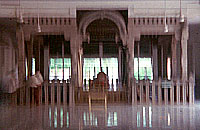 One of the most important forms of worship (or sadhana,
depending upon your point of view) is 'pradakshina',
which essentially is circumambulating a holy site,
such as Arunachala mountain. In the Ramana Maharshi
samadhi site hall, it is a common practice to encircle
the samadhi altar, which is an area of around 50 by
50 feet. People circumambulate 3 times or more, while
priests are doing pujas or attending to the altar
area. I did my first of many pradakshina around the
hall.
One of the most important forms of worship (or sadhana,
depending upon your point of view) is 'pradakshina',
which essentially is circumambulating a holy site,
such as Arunachala mountain. In the Ramana Maharshi
samadhi site hall, it is a common practice to encircle
the samadhi altar, which is an area of around 50 by
50 feet. People circumambulate 3 times or more, while
priests are doing pujas or attending to the altar
area. I did my first of many pradakshina around the
hall.
Kumar asked me if I wanted to do a circumambulation
of Arunachala mountain that night. I hesitatingly said
yes, wondering if I could handle the walk at night.
And usually one does pradakshina barefoot, but this
tenderfoot could not handle that. Kumar told me
that it was most auspicious to first go to the
large Arunachleswara temple before circumambulation.
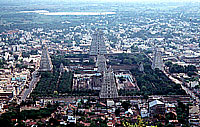 This is a huge temple upon which the town of Thirumvanammalai
is built around, comprising of approximately ten
acres. It has 9 towers of varying sizes, the tallest,
being the main gate, is a least 7 stories or more.
Each tower is magnificently carved with various
gods and goddesses of India. The back of the temple
is the base of Arunachala mountain, which towers
over the city.
This is a huge temple upon which the town of Thirumvanammalai
is built around, comprising of approximately ten
acres. It has 9 towers of varying sizes, the tallest,
being the main gate, is a least 7 stories or more.
Each tower is magnificently carved with various
gods and goddesses of India. The back of the temple
is the base of Arunachala mountain, which towers
over the city.
There are actually two routes to circumambulate
Arunchala mountain - one is the main route, which
consists of walking down several roads that circle
the mountain. However, over the years, Thirumvannamalai
has experienced a urban sprawl like many cities in
India and the world, and can be a very noisy and
annoying place. So many people take the roads at
night to minimize the loud and obnoxious local
busses, pissing out streams of diesel smoke,
crazy taxi and autorickshaw drivers. It can certainly
cut into the experience, so night time is best to
do the pradakshina.
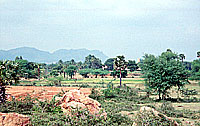 There is also an inner route for
circumambulation, but the final quarter of this
route dumps you in downtown Thiru, which is much,
much larger than what I had expected.
There is also an inner route for
circumambulation, but the final quarter of this
route dumps you in downtown Thiru, which is much,
much larger than what I had expected.
Right across the street from the ashram was a sign for the Ram Surat Kumar ashram. Ram Surat Kumar was a sadhu for many years in Thiru, then he began to generate a following, which included the American teacher Lee Lozowicz, and now he is greatly revered in the area. There was a 4-6PM satsang that night preceeded by a darshan of him, as he is driven from his house nearby to his new ashram site. Kumar and I walked down the streets, and he seemed to know a lot of people, until we arrived at the road leading to his ashram. We were just in time to see Kumar's Ambassador taxi come by. He was in the back seat looking up at the sky as he passed by me. There was no experience that occurred for me, and basically I felt that I was there for retreat at Ramana ashram - this particular teacher was not someone I had much interest in right at that point. We also looked into another famous teacher in town, Nana Guru, but he was out of town in his other ashram in the neighboring state in India.
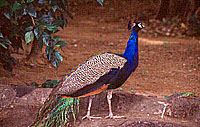 We were to do the main road route for the evening,
but not before a stop for chai at a small restaurant
across the street from the ashram. This restaurant,
which is bascally a large circular thatched patio,
is run by a German man who apparently has 4 wives
from four different states of India. I don't know
if that's true, and didn't know polygamy was allowed
in India.
We were to do the main road route for the evening,
but not before a stop for chai at a small restaurant
across the street from the ashram. This restaurant,
which is bascally a large circular thatched patio,
is run by a German man who apparently has 4 wives
from four different states of India. I don't know
if that's true, and didn't know polygamy was allowed
in India.
Arunachleswara Temple
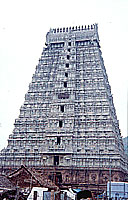 So at dusk, we start out towards Arunachleswara
temple in downtown Thirumvannamalai (notice how
South Indian names are reallly long?!). And I
quickly discovered that Thiru is a lot bigger and
noisier than I had thought. When we got to the
temple, it's size really hits you - it's like a
large fortress to the Gods of Hinduism. So we checked
our shoes in at the temple shoe place and proceeded
to go inside. Kumar gave me a tour of all of the
various temples inside the complex, and there were
many, dedicated to numerous Gods, such as Shiva,
Lord Ganesh, Lord Muruga (Shiva's other child, in
addition to Ganesh), and so many others that I cannot
recall. The temple complex also has a large water
tank for bathing/purification and also has an
elephant on the grounds - it's not often one
stands next to an elephant, though this one was
on the small side.
So at dusk, we start out towards Arunachleswara
temple in downtown Thirumvannamalai (notice how
South Indian names are reallly long?!). And I
quickly discovered that Thiru is a lot bigger and
noisier than I had thought. When we got to the
temple, it's size really hits you - it's like a
large fortress to the Gods of Hinduism. So we checked
our shoes in at the temple shoe place and proceeded
to go inside. Kumar gave me a tour of all of the
various temples inside the complex, and there were
many, dedicated to numerous Gods, such as Shiva,
Lord Ganesh, Lord Muruga (Shiva's other child, in
addition to Ganesh), and so many others that I cannot
recall. The temple complex also has a large water
tank for bathing/purification and also has an
elephant on the grounds - it's not often one
stands next to an elephant, though this one was
on the small side. 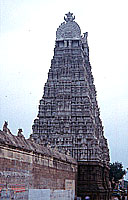
One temple of note was an underground chamber that seemed very potent, and it was here where Ramana Maharshi meditated for 20 days straight with no food or water, with ants eating away at his skin. The temple priests, recognizing that this was no ordinary yogi, proceeded to take care of him.
Arunachala Mountain Circumbulation
The temple was a bit overwhelming, and I didn't feel at the moment very connected to the Hindu pantheon. So finally, after a bite to eat we began circumabmulating Arunachala mountain. Once we got outside of downtown Thiru, the roads became very quiet, much to my relief - the tooting of bus horns can really get to you, not to mention the pollution. But as we walked, the quietness of the night was comforting, and I found myself becoming very joyful.
Along the roadside, there are many small temples which Kumar stopped to say a prayer. And I kept looking at the mountain, but it didn't seem to change much in the dark, though it felt blissful. At one point, I realized that I had horrific blisters on my feet, from my mediocre quality Indian sneakers. A circumambulation of Arunachala is supposed to be done in one's bare feet, but this tenderfoot didn't think he could handle two hours of skin to tarmac. But, nevertheless, I stilled paid a painful price in blistering feet.
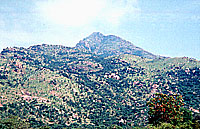 We passed numerous groups of people doing the
same circumambulation, and due to nightime
disorientation, it didn't feel to me that we
were walking in circles around the mountain.
I was also getting very tired and worn out,
though blissed out at the same time, which
kept me going. Finally we arrived back at
Ramana Ashram, and I swear there was some kind
of time/space warp - it just didn't seem that
we walked around the mountain, but apparently
we did! I bid Kumar a goodnight and headed
straight to bed.
We passed numerous groups of people doing the
same circumambulation, and due to nightime
disorientation, it didn't feel to me that we
were walking in circles around the mountain.
I was also getting very tired and worn out,
though blissed out at the same time, which
kept me going. Finally we arrived back at
Ramana Ashram, and I swear there was some kind
of time/space warp - it just didn't seem that
we walked around the mountain, but apparently
we did! I bid Kumar a goodnight and headed
straight to bed.
Ashram Food
 Everyone washes the banana leaf with some
of the water from the cup, and the food
detail comes around with large pails of food
of various kinds, and slaps the food onto
the banana leaf, kinda like sloppin' the
hogs. But the food is excellent, and you
can eat as much as you want. There are
different foods prepared for Indians and
westerners, and the servers come around
and say, "spicy!", and you have the choice
to take it or not. I took the spicy food
on several occasions and it wasn't that
bad. There are no utensils provided - in
South India, all foods are eaten with one's
good old hands, but a few folks brought
their own utensil, which I did on subsequent
meals. When one is done eating, one folds
the banana leaf in half and walks out. On
the way out, I looked at numerous pictures
of Ramana, his mother and various disciples
throughout the years, which decorate the
walls.
Everyone washes the banana leaf with some
of the water from the cup, and the food
detail comes around with large pails of food
of various kinds, and slaps the food onto
the banana leaf, kinda like sloppin' the
hogs. But the food is excellent, and you
can eat as much as you want. There are
different foods prepared for Indians and
westerners, and the servers come around
and say, "spicy!", and you have the choice
to take it or not. I took the spicy food
on several occasions and it wasn't that
bad. There are no utensils provided - in
South India, all foods are eaten with one's
good old hands, but a few folks brought
their own utensil, which I did on subsequent
meals. When one is done eating, one folds
the banana leaf in half and walks out. On
the way out, I looked at numerous pictures
of Ramana, his mother and various disciples
throughout the years, which decorate the
walls.
 Back |
 Next, On and Around The Mountain |
|
|
Page 12. |
||
